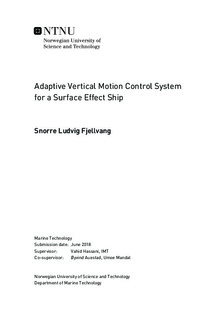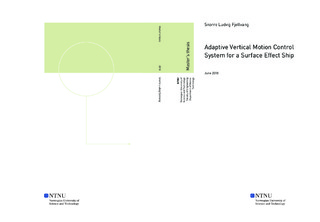| dc.description.abstract | In this thesis, an adaptive controller is developed, with the purpose of actuating the pressure of the air cushion of a Surface effect ship (SES), as means of reducing wave induced vertical vessel motions.
The rise in the offshore wind industry increases the demand for accessibility to wind turbines, which are located increasingly far off-shore. This sets new requirements for safety, with regards to both operations and maintenance. In general, the offshore wind industry is looking for new ways of utilizing the vessels characteristics to access turbines in rougher seas.
Control systems using actuation of the air cushion pressure to achieve active damping of vertical vessel motions are in existence today. However, operators are required to manually adjust the tuning parameters for the SES Motion Control System. By establishing a control system based on an adaptive control law, the crew members could be relieved of these tasks.
The basis for the control problem is that the controller parameters which provide the desired damping response, vary for the different operating conditions of the vessel. Changing environmental conditions and whether damping is desired directed towards the bow or the center of gravity, are factors contributing to why the current control system needs attention from the crew members. A poorly tuned controller may lead to wear on the actuators, cause vibrations or compromise the damping performance of the system. These are all aspects which have been taken into consideration in the design of the developed adaptive control system.
To test the adaptive controller, simulation models are used. These models are the results of decades of research and development of a mathematical description for the particular dynamics of the Surface Effect Ship. A simplified control plant model which incorporates the necessary vertical dynamics is implemented for the purpose of developing the controller. A more complex process plant model is supplied by UMOE Mandal and is used for verification purposes.
The controller is tested in simulations designed to emulate a range of different conditions which the vessel may encounter. Simulations are performed for regular and irregular sea states of varying amplitude and frequency, in addition to the application of control to both the bow and center of gravity of the vessel. The results show that the adaptive controller is able to achieve a desirable response in the range of the operating conditions tested. | |

